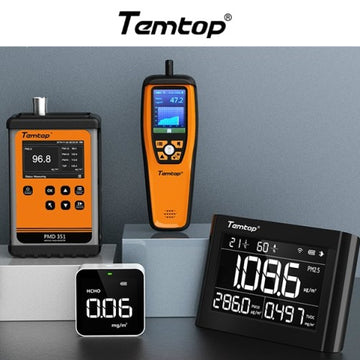A Brief Introduction to Air Quality Monitor
Have you noticed that your nose never itches or sneezes anywhere? This is mainly because the air you breathe is not very clean. Indoor air is 5% more polluted than outdoor air. Now you will really think you should invest in quality air quality monitors.
Indoor air also keeps out dust and other harmful pollutants. There were all sorts of other machines and equipment around us, and there was a lot of traffic outside. It's not safe under any circumstances. By installing a state-of-the-art air quality monitor in your house or room, you will be informed of the current state of air pollutants in your breath.
Buying air quality monitors is not easy. There are so many products on the market that it is difficult to choose the right one. So, we've created this simple shopping guide to help you.
What is an air quality monitor?
Monitoring air pollution is the practice of assessing air pollution in different environments in an area. The assessment results indicate the current air quality in that particular area. An air quality monitor is the device that performs this operation and provides the results.
Currently, the indoor air quality monitor has three different sensors that measure carbon dioxide, carbon monoxide and oxygen. Oxygen and carbon monoxide sensors are electrochemical sensors, while carbon dioxide sensors are infrared sensors.
The electrochemical sensor is based on fuel and can detect oxidized gases. The infrared sensor absorbs the energy of the beam based on the concentration of carbon dioxide. Both sensors convert information into data and deliver results.
The elements of an air quality monitor can be measured
Formaldehyde/HCHO
A colorless, toxic, highly water-soluble gas with an unpleasant odor. Used in the manufacture of hundreds of industrial and consumer products such as disinfectants, preservatives and adhesives, carpets, decorative panels, foam insulation, curtains, textiles and particleboard, and permanently pressed fabrics.
VOC/TVOC
Volatile organic compounds, or vocs, are gaseous pollutants released into the atmosphere that can have negative health effects. The most famous of these compounds is formaldehyde. The compound is contained in building materials, fertilizers and adhesives. It just shows how dangerous it is to human health! VOC is measured in billionths of a billionth.
CO2
Carbon dioxide is a small, naturally occurring gas in our atmosphere. It also emits the gas, which is produced when the exhaust gas is burned. This increase in gas content is harmful and can increase without proper ventilation. The gas is measured in parts per million.
Particle Matters/PM
Fine dust or fine dust lingers in the air around us. These particles contain dust and pollen. In addition to these, there are other particles that can enter the lungs when inhaled. This could have direct health effects.
If not filtered correctly, particles can come from a variety of sources, including combustion and cooking. Each size currently has a different PM. PM2.5 is particles smaller than 2.5 microns, while PM10 is particles larger than 2.5 microns but less than 10 microns. It's measured over time.
Temperature and Humidity
These two factors also exist in indoor air pollution measurements. The reason is that low temperatures and high humidity promote the growth of mold and mites. This condition can promote allergens and asthma.
On the other hand, low humidity is not a good thing because it can cause irritation and dry skin and other breathing problems. As a result, air quality monitors must also provide information about these two factors, rather than buying separate sensor equipment here.
Product List: https://www.temtop.co.uk/collections/all-product

























